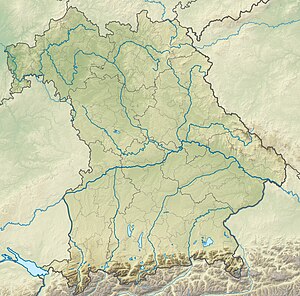Steinhart Castle
| Steinhart Castle | ||
|---|---|---|
| Alternative name (s): | Old castle | |
| Creation time : | 1100 to 1200 | |
| Castle type : | Höhenburg, spur location | |
| Conservation status: | Enclosing walls | |
| Standing position : | Nobles, counts | |
| Construction: | Humpback cuboid | |
| Place: | Hainsfarth - Steinhart | |
| Geographical location | 48 ° 57 '35.2 " N , 10 ° 40' 33.2" E | |
| Height: | 510 m above sea level NN | |
|
|
||
The castle Steinhart , and Old Castle called, is the ruins of a hilltop castle on a 510 m above sea level. NN high hill above the Steinhart district of the municipality of Hainsfarth in the Donau-Ries district in Bavaria .
history
In the 12th century, Marquard Spet de Steinenhart, who was mentioned as a witness in a document in 1120, built the castle above the village of Steinhart and in 1130 a "Bertholdus Späth, nobilis de Steinhart" was mentioned. Further mentions of Spete took place in 1167 with Heinrich Spet and Bertold Spet from 1180 to 1183. From 1282 the lords of Spet called themselves Spete von Steinhart (the “late von Steinhart”).
In 1282, the Spetsche property was divided into two lines, with part coming to Faimingen an der Donau , a current district of the city of Lauingen .
Presumably the "Old Castle" was destroyed in the war for the Eichstätter fiefs and not rebuilt. The Jewish cemetery has been located on the hill of the abandoned castle with a ring-shaped moat, the Steinhart stables , also known as Judenbuck, since the 18th century .
After Herman Spet received permission to build a new fortress in Steinhart in 1328, the new Steinhart Castle, now also known as the “Old Castle”, was built strategically above the castle stable.
After 1339 the castle changed hands and came to the Counts of Öttingen , who sold the property to the von Gundelsheim family in 1359 .
After the castle was in a poor structural condition as early as 1532, it changed hands and was probably destroyed in the Thirty Years' War in 1634 . The ruin has been privately owned since 1971.
Significant remnants of the enclosing walls with humpback ashlars with edging at the corners are still preserved from the former rectangular castle complex with a bailey on a trapezoidal floor plan .
literature
- Wilfried Sponsel, Hartmut Steger: Past castles and mansions - a search for traces in the view of the Ries. Typesetting and graphics partner, Augsburg 2004, ISBN 3-935438-27-3 , pp. 132-137.


